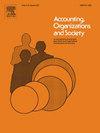The effect of different approaches to administering a fixed wage raise on employee productivity
IF 3.6
2区 管理学
Q1 BUSINESS, FINANCE
引用次数: 0
Abstract
Firms frequently implement pay increases as a critical part of the management control system. We investigate how controllable factors related to the timing of such increases affect employee productivity. In practice, significant variation exists between when firms (i) announce a pay increase, (ii) quantify it, and (iii) make it effective. These events can occur concurrently (i.e., in the same pay period) or sequentially at different points in time (i.e., spread across several pay periods). We posit that varying the temporal separation of these events can affect employees’ effort and pattern of productivity. Via an experiment, we find employees respond to concurrent pay increases by initially providing high levels of effort that nonetheless diminishes significantly over time. In contrast, we find that they respond to sequential pay increases with a smaller but more persistent increase in effort, leading to equivalent levels of total output at a lower total compensation cost. However, our study also documents that employees have less satisfaction with the timing of the raise for sequential compared to concurrent raises. Our study provides insights for theory and practice regarding the benefits and costs of concurrent versus sequential raises.
管理固定加薪的不同方法对员工生产力的影响
公司经常把增加工资作为管理控制系统的一个关键部分来实施。我们研究了与这种增加的时间相关的可控因素如何影响员工的生产力。在实践中,企业(i)宣布加薪,(ii)量化加薪,以及(iii)使加薪生效之间存在显著差异。这些事件可以同时发生(即,在同一工资期),也可以在不同的时间点依次发生(即,分布在几个工资期)。我们假设改变这些事件的时间分离可以影响员工的努力和生产力模式。通过一项实验,我们发现员工对同时加薪的反应是,最初会付出高水平的努力,但随着时间的推移,这种努力会显著减少。相比之下,我们发现他们对连续加薪的反应是较小但更持久的努力增加,从而在较低的总补偿成本下达到相同的总产出水平。然而,我们的研究也表明,与同期加薪相比,员工对连续加薪时间的满意度较低。我们的研究为并行加薪与连续加薪的利弊提供了理论和实践的见解。
本文章由计算机程序翻译,如有差异,请以英文原文为准。
求助全文
约1分钟内获得全文
求助全文
来源期刊

Accounting Organizations and Society
BUSINESS, FINANCE-
CiteScore
7.80
自引率
6.40%
发文量
38
期刊介绍:
Accounting, Organizations & Society is a major international journal concerned with all aspects of the relationship between accounting and human behaviour, organizational structures and processes, and the changing social and political environment of the enterprise.
 求助内容:
求助内容: 应助结果提醒方式:
应助结果提醒方式:


